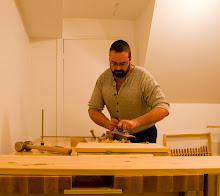My question, of course, is who cares? We're talking about less than two and a half degrees difference between the whole range of them. Who is going to be able to tell what ratio you used when looked at from any kind of a distance. A person with a good eye might be able to guess, but you'd need to take a gauge to the piece to be sure, and anyone who takes a gauge to anything I made deserves whatever disappointment might be forthcoming. :)
So what do I use? I use the 1:6 ratio for all woods. I figure if it's going to be a dovetail then I might as well pick the one that looks the most like a dovetail.
Below we see a quickly cobbled dovetail that I just did this morning for the sake of illustrating this point. This joint has two tails. One is at 1:6 and one is at 1:8. Even right side by side and zoomed in it's not that obvious that they're different angles. At most you might think that it was a minor variation caused by hand-cut joinery. Certainly it wouldn't scream at you from across the room. So I, for one, don't get all excited about dovetail angles.

Frank Klaus, master cabinetmaker and father of dovetail excitement on this continent, doesn't use a gauge. He eyeballs the angles. He doesn't even measure out the spacing. He eyeballs everything except the depth of the cut (which must match the thickness of the board being joined to). Despite his carefree methodology, his experience is legendary and he can cut seemingly air-tight dovetails in the time it takes most experts to do the layout.

3 comments:
It's worth noting that Klausz advocates this school of dovetailing to "mere mortals" as well. Angle is almost irrelevant (I've seen recommendations ranging from 7 degrees to 15 degrees). Spacing is irrelevant. Your layout marks are important and he takes some time with them, transferring the tails to the pins (or vica versa) is important and he takes some time with them, sawing accurately is important.
Now, that said, having tried this myself with my own limited experience I got kinda funky looking dovetails because I wasn't careful enough to use about the same angle each time, and they're gappy because I saw poorly. But if I don't get better at sawing no technique will work, and inattention will kill me every time. :)
Too true! The sawing is the key. I got a tip the other day that I've been playing with, and I'm actually not sure if it was a good tip or not. I was told to look at the two layout lines (side and end) at an angle such that the two lines form one straight line, then line up your saw with that and saw from the corner and flatten out as you go. This seems to work, but I feel the saw bind when I flatten out. I'm going to keep playing with the notion.
I find the single biggest hurdle between me and good dovetail sawing is having a line that I can really SEE. I have a bad habit of over-running the depth line.
M.Mike
Being in the process of building a hard maple (12/4) console. I found out few things about dovetailing.
Pencil lines are great but and actual chalked scribed path "leads" the saw. Also make sure to hash out the waste so one unfortunate chisel blow does not end up on the wrong side. In order to take out the human variable I sandwich the depth line with hickory. And as i am about to go too deep i go into the top scrap flip the piece and repeat. Also when i saw i try not to get frustrated and will take my time. Also undercutting is important but mostly.... sharp chisels and patience. Then sharpen them to both. Also skewed chisels for cleaning up and fine tuning. Olivier. foreignangle.com
Post a Comment